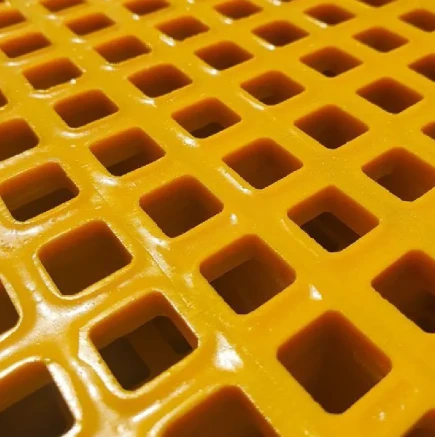loading...
- No. 9, Xingyuan South Street, Dongwaihuan Road, Zaoqiang County, Hengshui, Hebei, China
- admin@zjcomposites.com
- +86 15097380338
- Welcome to visit our website!
Durable Fibreglass Mesh Grating - Lightweight, Corrosion-Resistant
- Introduction to fibreglass mesh grating
- Material composition and structural design
- Technical advantages over alternatives
- Key manufacturer comparisons
- Customization options
- Industry application cases
- Operational benefits and maintenance guidance

(fibreglass mesh grating)
Understanding Fibreglass Mesh Grating Systems
Modern industrial flooring solutions increasingly utilize pultruded composite technology where glass fibres combine with thermosetting resins under high pressure. These fibreglass mesh grating systems feature grid-like configurations with bidirectional reinforcement - ideal for corrosive environments. According to industry reports, global demand increased by 17% from 2019-2022 as plants replace traditional steel platforms.
Material Composition and Structural Design
Premium resin formulations incorporate orthophthalic polyester or bisphenol vinyl ester matrices, creating chemical resistance properties essential for petrochemical facilities. Unlike continuous surfaces, the open grid design achieves optimal strength-to-weight ratios - typically 1.8 SG compared to steel's 7.8 SG. This structural approach enables direct UV stabilization without additional coatings.
Performance Advantages Over Metal Solutions
Corrosion resistance remains the primary benefit, eliminating oxidation concerns common with carbon steel alternatives. Testing reveals less than 0.05% mass loss after 3,000 hours in salt-spray chambers (ASTM B117). Slip resistance metrics exceed OSHA requirements with DIN 51097 Class R11 ratings. Laboratory impact tests demonstrate 100% structural integrity after 25 J/cm² strikes.
Manufacturer Comparison Specifications
| Manufacturer | Resin System | Max Load (PSF) | Thermal Range | Fire Rating |
|---|---|---|---|---|
| Fibergrate | Vinyl Ester | 1,250 | -60°F to 300°F | ASTM E84 Class 1 |
| Strongwell | Polyester-Iso | 980 | -40°F to 250°F | BS 476 Part 7 |
| Bedford | Modified Polyester | 1,100 | -30°F to 270°F | UL 94 HB |
Customization Options for Specialized Applications
Custom fabrication enables panel modifications exceeding standard 24"x96" dimensions. Water treatment plants often specify fibreglass walkway mesh with non-sand grit surfaces and specialized resin blends resisting sulphur compounds. Offshore platforms require fibreglass mesh walkway sections integrating UV-stabilized coatings with 65% light transmittance specifications.
Industrial Application Success Stories
A Texas refinery replaced carbon steel catwalks with resin-infused grating, reducing annual maintenance costs by $127,000. Wastewater facilities report lifespan exceeding 22 years despite chlorine exposure. Semiconductor fabs leverage electromagnetic transparency characteristics impossible with metallic alternatives. All installations maintained 100% OSHA fall-protection compliance.
Optimizing Fibreglass Mesh Grating Operations
Proper installation requires specialized aluminum clamping systems spaced at 36" intervals maximum. Prevent surface degradation using neutral pH cleaners only. Quarterly inspections should verify secure anchoring while checking for impact damage near equipment access points. Documented case studies show correctly maintained installations deliver 50+ years service life - outperforming coated steel alternatives by 300% in corrosive settings. These composite systems will increasingly dominate industrial flooring with projected 8.4% CAGR through 2030 as chemical processing facilities modernize infrastructure.

(fibreglass mesh grating)
FAQS on fibreglass mesh grating
Q: What is fibreglass mesh grating used for?
A: Fibreglass mesh grating is primarily used for creating durable, slip-resistant surfaces in corrosive environments. It's ideal for industrial platforms, walkways, and trench covers due to its non-conductive properties. The material resists chemicals, moisture, and UV degradation.
Q: Where can fibreglass walkway mesh be installed?
A: Fibreglass walkway mesh is commonly installed in chemical plants, offshore platforms, and water treatment facilities. It provides safe footing for workers in wet or high-humidity areas like docks or cooling towers. Its lightweight design simplifies installation on existing structures.
Q: How does fibreglass mesh grating compare to steel alternatives?
A: Fibreglass mesh grating offers superior corrosion resistance and weighs only one-fourth of steel grating. It requires no painting or rust maintenance and provides natural electrical insulation. These properties reduce long-term costs despite a higher initial investment.
Q: What maintenance does a fibreglass mesh walkway require?
A: Fibreglass mesh walkways need minimal maintenance – occasional washing with water and mild detergent suffices. They don't corrode or rot, eliminating structural repairs. Inspect annually for impact damage, though UV-stabilized versions resist weathering degradation.
Q: Can fibreglass walkway mesh support heavy equipment?
A: Yes, properly engineered fibreglass walkway mesh handles industrial loads like forklifts or machinery. Load capacities vary by thickness/resin type (e.g., phenolic resin for extreme heat). Consult manufacturer load tables to ensure compliance with safety standards like OSHA.
-
The Rise of FRP Profiles: Strong, Lightweight, and Built to LastNewsJul.14,2025
-
SMC Panel Tanks: A Modern Water Storage Solution for All EnvironmentsNewsJul.14,2025
-
GRP Grating: A Modern Solution for Safe and Durable Access SystemsNewsJul.14,2025
-
Galvanized Steel Water Tanks: Durable, Reliable, and Ready for UseNewsJul.14,2025
-
FRP Mini Mesh Grating: The Safer, Smarter Flooring SolutionNewsJul.14,2025
-
Exploring FRP Vessels: Durable Solutions for Modern Fluid HandlingNewsJul.14,2025
-
GRP Structures: The Future of Lightweight, High-Performance EngineeringNewsJun.20,2025
